铸造专业毕业设计
- 格式:doc
- 大小:29.16 KB
- 文档页数:30
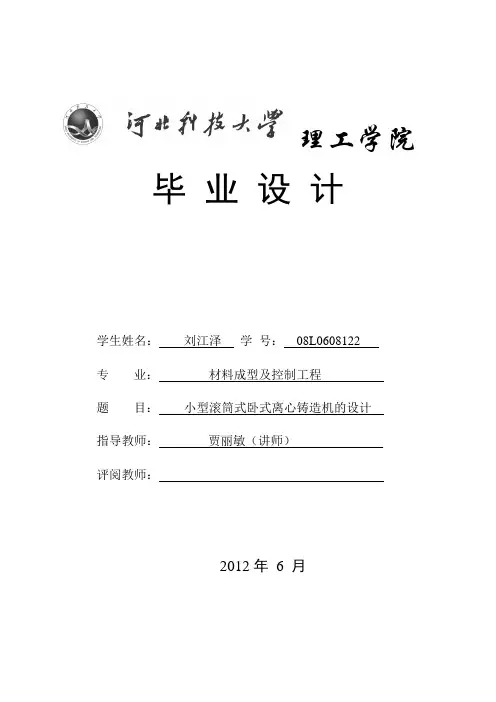
理工学院毕业设计学生姓名:刘江泽学号:08L0608122专业:材料成型及控制工程题目:小型滚筒式卧式离心铸造机的设计指导教师:贾丽敏(讲师)评阅教师:2012年6 月河北科技大学理工学院毕业设计成绩评定表姓名刘江泽学号08L0608122 成绩专业材料成型及控制工程题目小型卧式滚筒式离心铸造机的设计指导教师评语及成绩指导教师:年月日评阅教师评语及成绩评阅教师:年月日答辩小组评语及成绩答辩小组组长:年月日答辩委员会意见答辩委员会主任:年月日毕业设计中文摘要本文对滚筒形状离心铸件进行铸造工艺设计。
首先完成离心铸造工艺设计,对于生产条件的确定以及离心机的选择并对离心铸造的浇注温度、速度、时间和铸型转动时间进行确定。
根据零件设计出衬套、挡板和后盖,画出其零件图,并组装成整体模具图。
利用重力系数公式计算铸型转速,再根据公式计算转矩,选择联轴器和离合器。
然后根据转速计算出最小轴径,进而设计出整体的轴,并对轴进行了校核。
利用CAD绘制出小型滚筒式卧式离心铸造机的整体图形以及零件图。
关键词:卧式,离心铸造,滚筒,CAD毕业设计外文摘要Title Design of horizontal centerfugal casting machine with small drum shapedAbstractThe drum shape centrifugal casting foundry process design. First to complete the design of centrifugal casting process to determine the rotation time of the production conditions to determine the centrifuge selection and centrifugal casting,pouring temperature,speed,time,and cast. Bushings,bezel and back cover,according to the part design to draw the parts diagram,and assembled into the overall die map. Gravity coefficient was calculated as the casting speed,according to the formula to calculate torque,select the couplings and clutches. According to speed to calculate the minimum shaft diameter,and then design the whole axis and the axis was calibrated. Use of CAD drawing overall graphics and parts diagram of a small drum horizontal centrifugal casting machine.Key Words Horizontal Centrifugal casting Roller CAD目录1 绪论 (1)1.1铸造简介 (1)1.2离心铸造简介 (1)1.345钢简介 (3)1.4离心铸管机的设计原则 (4)1.5本课题研究的对象 (4)2 离心铸造工艺 (5)2.1生产条件的确定 (5)2.2金属模涂料 (6)2.3浇注温度 (8)2.4浇注速度 (8)2.5浇注系统 (8)2.6铸型转动时间 (9)3 离心铸管缺陷分析及预防 (10)3.1合金钢管缺陷分析 (10)3.2缺陷预防措施 (10)4 模具设计 (12)4.1模具的结构 (12)4.2模具参数的计算 (12)4.3铸型转速的计算 (14)5 零件的选择 (17)5.1联轴器的选择 (17)5.2离合器的选择 (19)5.3轴承的选择 (20)6 轴的设计 (22)6.1轴长的确定 (22)6.2轴的校核 (23)6.3键与销的选取和校核 (25)结论 (27)致谢 (22)参考文献 (22)1 绪论1.1 铸造简介1.1.1 铸造的定义铸造[1]是熔炼金属,制造铸型,并将熔融金属浇入铸型,凝固后获得具有一定形状、尺寸和性能金属零件毛坯的成型方法。
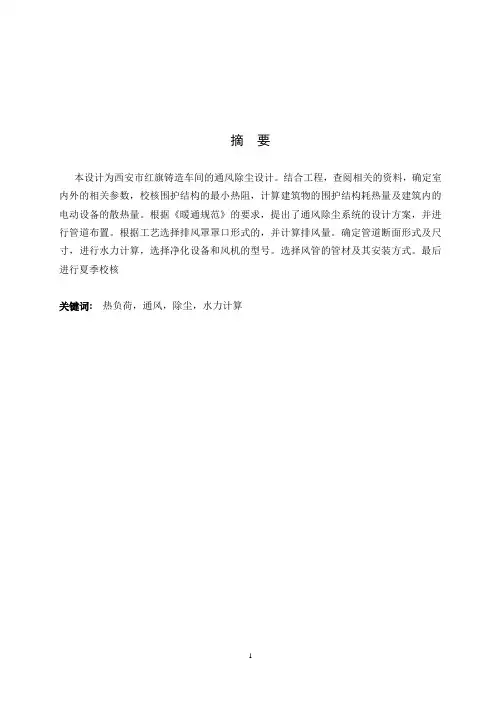
摘要本设计为西安市红旗铸造车间的通风除尘设计。
结合工程,查阅相关的资料,确定室内外的相关参数,校核围护结构的最小热阻,计算建筑物的围护结构耗热量及建筑内的电动设备的散热量。
根据《暖通规范》的要求,提出了通风除尘系统的设计方案,并进行管道布置。
根据工艺选择排风罩罩口形式的,并计算排风量。
确定管道断面形式及尺寸,进行水力计算,选择净化设备和风机的型号。
选择风管的管材及其安装方式。
最后进行夏季校核关键词: 热负荷,通风,除尘,水力计算ABSTRACTAThe design for the red flag foundry in xian is completed dnd ventilation dust removal are designed. Combined with engineering and accessde relevant information, the related is determined pheked.The heat comsuption of the palisade structure of the builing and the heat of the electric equipment are calculated. According to standards, the ventilation dust removal system design scheme, and piping layout is puts forword. According to the technology choice is decided , the exhaust air is calculate. Pipe section mode and dimensions,by the hydraulic calculation is decidarameters of room inside and outside. The palisade structure minimum thermal resistance is ced, purification equipment and fan models is choosed. The pipes and the installation way duct is chossed.Keywords: heating load ,ventilation,dust removal前言随着我国工业生产的快速发展,工业有害物的散发量日益增加,环境污染问题越来越严重。
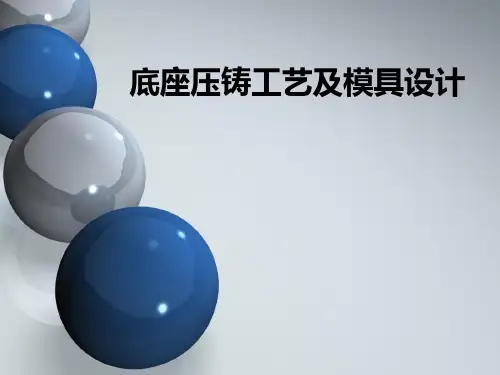
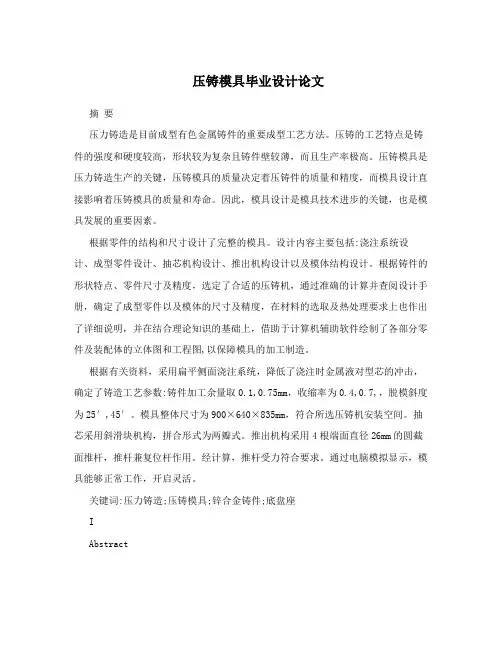
压铸模具毕业设计论文摘要压力铸造是目前成型有色金属铸件的重要成型工艺方法。
压铸的工艺特点是铸件的强度和硬度较高,形状较为复杂且铸件壁较薄,而且生产率极高。
压铸模具是压力铸造生产的关键,压铸模具的质量决定着压铸件的质量和精度,而模具设计直接影响着压铸模具的质量和寿命。
因此,模具设计是模具技术进步的关键,也是模具发展的重要因素。
根据零件的结构和尺寸设计了完整的模具。
设计内容主要包括:浇注系统设计、成型零件设计、抽芯机构设计、推出机构设计以及模体结构设计。
根据铸件的形状特点、零件尺寸及精度,选定了合适的压铸机,通过准确的计算并查阅设计手册,确定了成型零件以及模体的尺寸及精度,在材料的选取及热处理要求上也作出了详细说明,并在结合理论知识的基础上,借助于计算机辅助软件绘制了各部分零件及装配体的立体图和工程图,以保障模具的加工制造。
根据有关资料,采用扁平侧面浇注系统,降低了浇注时金属液对型芯的冲击,确定了铸造工艺参数:铸件加工余量取0.1,0.75mm,收缩率为0.4,0.7,,脱模斜度为25′,45′。
模具整体尺寸为900×640×835mm,符合所选压铸机安装空间。
抽芯采用斜滑块机构,拼合形式为两瓣式。
推出机构采用4根端面直径26mm的圆截面推杆,推杆兼复位杆作用。
经计算,推杆受力符合要求。
通过电脑模拟显示,模具能够正常工作,开启灵活。
关键词:压力铸造;压铸模具;锌合金铸件;底盘座IAbstractDie-casting molding technology is playing a key role in non-ferrous metal structure forming processes. Die-casting process’s features are the strength and hardness of die castingon high, thin-walled castings with complex shape can be cast, andthe production is efficient. The die-casting die is the key for the process of die casting, its quality decides the quality and accuracy of castings, and the design of the die-casting die affects its quality and operating life directly. Therefore, designing the die-casting die is the key to technological progress; it is also an important factor in the development of mold.Based mainly on parts of the design integrity of the structure and size, it scheme out the required spare parts. Design elements include: design of gating system, forming part design, core-pulling mechanism design, the ejector design and the mold body structure design. According to the shape of features , parts size and accuracy, the author selected the appropriate die casting machine, through the exactly calculate and consult design handbooks, confirm the size and accuracy of the forming part and mold body structure, it also makes particular instruction on the material selection and the requirements of the heat treatment, with theoretical basis, plotting out pictorial drawing and casting drawing of the parts by using computer software to ensure the manufacture of die-casting die.Based on the datum, use flat side gating system which can reduce pouring molten metal on the impact of cores, it ensure the technologicalparameter of the mold: the allowance of the casting was 0.1,0.75mm, shrinkage rate was 0.4,0.7,, draft angle was 25′,45′. The size of the die-casting mold was 900×640×835mm, which satisfy the space of the diecasting machine which is chosen. The core-pulling mechanism of the mold was optional side slider core-pulling mechanism, Introduced organizations selected two push plate. The diameter of the ejector pin with a cylindrical head was 26mm, and was also used as return pin. The stress of the ejector pin was conformance to the requirement by calculate. The simulation by computer shows that the mold works function normally, and it can dexterous and quickly to open.Keywords: die casting; die-casting mold; zinc alloy castings; subbaseII目录摘要 ..................................................................... (I)Abstract ........................................................... . (II)第1章绪论 ..................................................................... .....................................................1 1.1课题意义 ..................................................................... (1)1.1.1 压力铸造的特点 ..................................................................... . (1)1.1.2压铸模具设计的意义 ..................................................................... (2)1.2压铸发展历史、现状及趋势 ..................................................................... .. (2)1.2.1压铸的发展历史 ..................................................................... .. (2)1.2.2我国压铸产业的发展 ..................................................................... (3)1.2.3压铸产业的发展趋势 ..................................................................... ...............4 1.3毕业设计内容 ..................................................................... . (5)第2章压铸模具的整体设计 ...............................................................................................7 2.1 铸件工艺性分析...................................................................... .. (7)2.1.1 铸件立体图及工程图 ..................................................................... .. (7)2.1.2 铸件分型面确定 ..................................................................... . (8)2.1.3 浇注位置的确定 ..................................................................... ......................8 2.2 压铸成型过程及压铸机选用 ..................................................................... . (9)2.2.1 卧式冷室压铸机结构 ..................................................................... .. (9)2.2.2 压铸成型过程 ..................................................................... (10)2.2.3压铸机型号的选用及其主要参数 (11)2.3 浇注系统设计 ..................................................................... . (11)2.3.1 带浇注系统铸件立体图 ..................................................................... .. (11)2.3.2 内浇口设计 ..................................................................... . (12)2.3.3 横浇道设计 ..................................................................... . (12)2.3.4 直浇道设计 ..................................................................... . (14)2.3.5 排溢系统设计 ..................................................................... ........................ 14 2.4 压铸模具的总体结构设计 ..................................................................... (14)第3章成型零件及斜滑块结构设计 ..................................................................... ............ 17 3.1 成型零件设计概述 ..................................................................... ........................... 17 3.2浇注系统成型零件设计 ..................................................................... .................... 17 3.3 铸件成型零件设计 ..................................................................... (19)3.3.1 成型收缩率 ..................................................................... . (19)III3.3.2 脱模斜度 ..................................................................... . (20)3.3.3 压铸件的加工余量 ..................................................................... . (20)3.3.4铸件成型尺寸的计算 ..................................................................... ............. 20 3.4 成型零件装配图...................................................................... .............................. 23 3.5 斜滑块机构设计...................................................................... (24)3.5.1 侧抽芯系统概述 ..................................................................... .. (24)3.5.2 斜滑块机构基本结构 ..................................................................... (25)3.5.3 斜滑块的拼合形式 ..................................................................... . (26)3.5.4 斜滑块的导滑形式 ..................................................................... . (26)3.5.5 斜滑块尺寸设计 ..................................................................... .. (26)3.5.6 斜滑块抽芯机构表面粗糙度和材料选择 (28)3.5.7 弹簧限位销设计 ..................................................................... .. (28)3.5.8 斜滑块抽芯机构立体图和装配图 (28)第4章推出机构和模体设计 ..................................................................... ........................ 30 4.1 推出机构设计 ..................................................................... . (30)4.1.1 推出机构概述 ..................................................................... (30)4.1.2 推杆设计 ..................................................................... . (30)4.1.3 推板导向及限位装置设计...................................................................... . (32)4.1.4 复位机构设计 ..................................................................... (32)4.1.5 推出、复位零件的表面粗糙度、材料及热处理后的硬度 (34)4.1.6 推出机构装配工程图及立体图 (34)4.2 模体设计 ..................................................................... (36)4.2.1 模体设计概述 ..................................................................... (36)4.2.2 模体尺寸 ..................................................................... . (37)4.2.3模板导向的尺寸 ..................................................................... (37)4.2.4模体构件的表面粗糙度和材料选择 ........................................................... 38 4.3 模具总装图及工作过程模拟 ..................................................................... .. (38)4.3.1 模具总装立体图 ..................................................................... .. (38)4.3.2 模具工作过程模拟图 ..................................................................... (38)第5章结论 ..................................................................... (41)参考文献 ..................................................................... .. (42)致谢 ..................................................................... .. (44)附录 ..................................................................... .. (45)IV沈阳工业大学本科生毕业设计第1章绪论1.1课题意义1.1.1 压力铸造的特点高压力和高速度是压铸中熔融合金充填成型过程的两大特点。
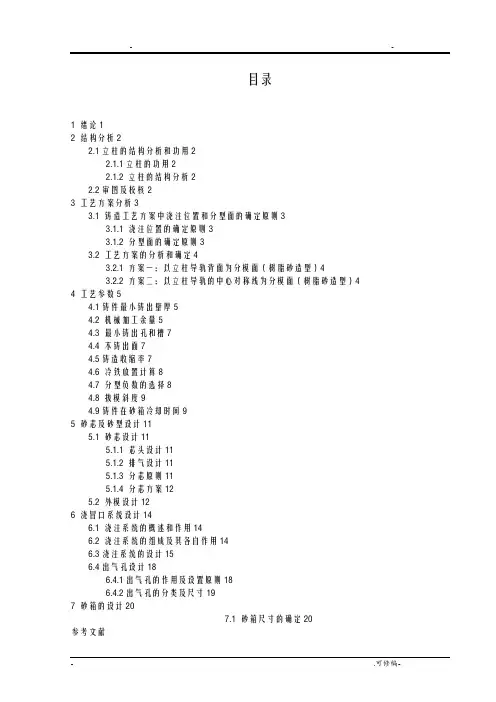
目录1 绪论12 结构分析22.1立柱的结构分析和功用22.1.1立柱的功用22.1.2 立柱的结构分析22.2审图及校核23 工艺方案分析33.1 铸造工艺方案中浇注位置和分型面的确定原则33.1.1 浇注位置的确定原则33.1.2 分型面的确定原则33.2 工艺方案的分析和确定43.2.1 方案一:以立柱导轨背面为分模面(树脂砂造型)43.2.2 方案二:以立柱导轨的中心对称线为分模面(树脂砂造型)44 工艺参数54.1铸件最小铸出壁厚54.2 机械加工余量54.3 最小铸出孔和槽74.4 不铸出面74.5铸造收缩率74.6 冷铁放置计算84.7 分型负数的选择84.8 拔模斜度94.9铸件在砂箱冷却时间95 砂芯及砂型设计115.1 砂芯设计115.1.1 芯头设计115.1.2 排气设计115.1.3 分芯原则115.1.4 分芯方案125.2 外模设计126 浇冒口系统设计146.1 浇注系统的概述和作用146.2 浇注系统的组成及其各自作用146.3浇注系统的设计156.4出气孔设计186.4.1出气孔的作用及设置原则186.4.2出气孔的分类及尺寸197 砂箱的设计207.1 砂箱尺寸的确定20参考文献致附录1 绪论铸造业发展简介铸造是一种古老的制造方法,在我国可以追溯到6000年前。
随着工业技术的发展,铸大型铸件的质量直接影响着产品的质量,因此,铸造在机械制造业中占有重要的地位。
铸造技术的发展也很迅速,特别是19世纪末和20世纪上半叶,出现了很多的新的铸造方法,如低压铸造、瓷铸造、连续铸造等,在20世纪下半叶得到完善和实用化[2]。
由于现今对铸造质量、铸造精度、铸造成本和铸造自动化等要求的提高,铸造技术向着精密化、大型化、高质量、自动化和清洁化的方向发展,例如我国这几年在精密铸造技术、连续铸造技术、特种铸造技术、铸造自动化和铸造成型模拟技术等方面发展迅速。
中国铸造工艺装备同先进国家相比还有一定差距。
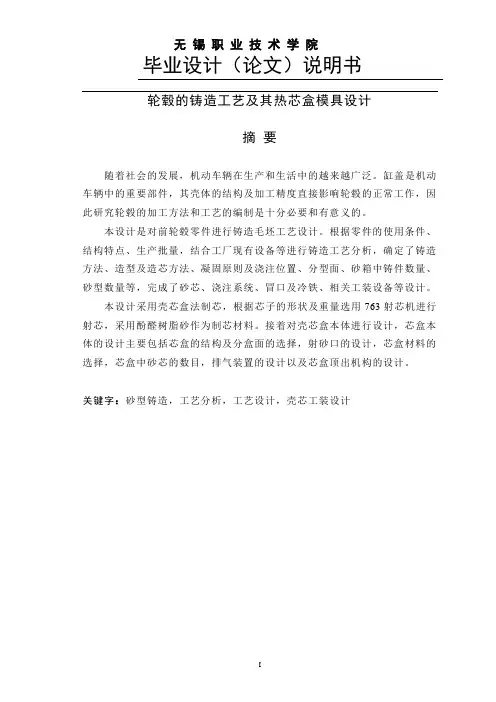
轮毂的铸造工艺及其热芯盒模具设计摘要随着社会的发展,机动车辆在生产和生活中的越来越广泛。
缸盖是机动车辆中的重要部件,其壳体的结构及加工精度直接影响轮毂的正常工作,因此研究轮毂的加工方法和工艺的编制是十分必要和有意义的。
本设计是对前轮毂零件进行铸造毛坯工艺设计。
根据零件的使用条件、结构特点、生产批量,结合工厂现有设备等进行铸造工艺分析,确定了铸造方法、造型及造芯方法、凝固原则及浇注位置、分型面、砂箱中铸件数量、砂型数量等,完成了砂芯、浇注系统、冒口及冷铁、相关工装设备等设计。
本设计采用壳芯盒法制芯,根据芯子的形状及重量选用763射芯机进行射芯,采用酚醛树脂砂作为制芯材料。
接着对壳芯盒本体进行设计,芯盒本体的设计主要包括芯盒的结构及分盒面的选择,射砂口的设计,芯盒材料的选择,芯盒中砂芯的数目,排气装置的设计以及芯盒顶出机构的设计。
关键字:砂型铸造,工艺分析,工艺设计,壳芯工装设计The Casting Technology and Hot Core BoxMold Design of HubABSTRACTAlong with social develop ment, motor vehicle used in production and life is increasingly wide. Hub is an important vehicle component and its interior structure and processing precisio n directly affect the hub normal work. Study hub cast processing methods and techniq ues of preparation is ne cessary and meaningful.This design is the casting techno logy design for front hub in vehicle. According to the application cond itions, structural features, production batch and existing equipment, it determines the method of casting, modeling, core making, solid ification principles and pouring position, parting surface, the quantity o f casting and mo ld etc. It comp letes the design of sand core, pouring system, riser, chill and related equipment etc.This design uses the shell core box mak ing core. According to the shape and weight it choose 763 shoot core machine shoot core and use phenolic resin sand as the core mak ing material. Then design the shell core box body, the core box body design mainly includes the core box structure and box surface selectio n, sand jetting port core box design, choice of materials, core box of sand core in number, exhaust design and installation o f the core box lifting mechanism design.KEY WORDS:sand casting,technolo gy analysis,techno logy design,Shell core fixture design目录前言 (1)第一章铸造工艺设计 (2)§1.1 零件概述 (2)§1.1.1 零件信息 (2)§1.1.2 技术要求 (2)§1.2 铸造工艺方案的确定 (3)§1.2.1 造型、造芯方法及铸型种类的确定 (3)§1.2.2 浇注位置和分型面的确定 (3)§1.2.3 砂箱中铸件数目的确定 (6)§1.3工艺参数的选择 (7)§1.3.1 铸造收缩率 (7)§1.3.2 机械加工余量、铸件的尺寸和重量偏差 (7)§1.3.3 拔模斜度的确定 (8)§1.3.4 铸造圆角的确定 (8)§1.3.5 最小铸出口及槽 (8)§1.4 浇注系统的设计 (8)§1.4.1 浇注系统的概述 (8)§1.4.2 浇注系统类型的选择 (9)§1.4.3 浇注系统的设计与计算 (10)§1.4.4 出气孔的设计 (13)§1.5 砂芯的设计 (13)§1.5.1 砂芯的概述 (13)§1.5.2 砂芯数量的确定 (14)§1.5.3 芯头的设计 (14)§1.5.4 壳芯的制备 (15)§1.6 冒口及冷铁的设计 (15)§1.6.1 冒口的设计 (15)§1.6.2 冷铁的设计 (16)第二章铸造工艺装备设计 (17)§2.1 模板 (17)§2.1.1 模样的设计 (17)§2.1.2 模底板的设计 (17)§2.2 壳芯工装设计 (18)§2.2.1 壳芯的概述 (18)§2.2.2 壳芯工艺 (18)§2.2.3 壳芯盒的材料 (20)§2.2.4 壳芯工装设计 (20)结论 (25)参考文献 (26)致谢 (27)前言近年来,能源,环境和安全问题受到普遍关注,汽车行业尤为突出。
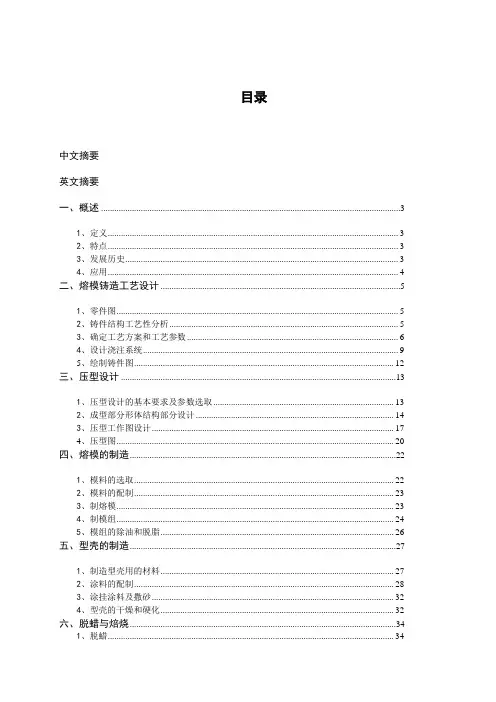
目录中文摘要英文摘要一、概述 (3)1、定义 (3)2、特点 (3)3、发展历史 (3)4、应用 (4)二、熔模铸造工艺设计 (5)1、零件图 (5)2、铸件结构工艺性分析 (5)3、确定工艺方案和工艺参数 (6)4、设计浇注系统 (9)5、绘制铸件图 (12)三、压型设计 (13)1、压型设计的基本要求及参数选取 (13)2、成型部分形体结构部分设计 (14)3、压型工作图设计 (17)4、压型图 (20)四、熔模的制造 (22)1、模料的选取 (22)2、模料的配制 (23)3、制熔模 (23)4、制模组 (24)5、模组的除油和脱脂 (26)五、型壳的制造 (27)1、制造型壳用的材料 (27)2、涂料的配制 (28)3、涂挂涂料及撒砂 (32)4、型壳的干燥和硬化 (32)六、脱蜡与焙烧 (34)1、脱蜡 (34)2、脱蜡的工艺过程 (34)3、模料的回收处理 (34)4、焙烧 (35)七、熔炼与浇注 (36)1、黄铜的特性 (36)2、黄铜的牌号选用 (37)3、锰黄铜的熔炼准备 (37)4、中间合金 (38)5、熔剂 (39)6、配料 (39)7、熔炼工艺 (40)8、浇注 (41)八、铸件的后处理 (42)1、熔模铸件清理 (42)2、从铸件和金属浇注系统上清除新型壳 (42)3、铸件上残留耐火材料的清除 (42)参考文献 (44)致谢 (45)一、概述1、定义熔模铸造又称"失蜡铸造",通常是在蜡模表面涂上数层耐火材料,待其硬化干燥后,将其中的蜡模熔去而制成型壳,再经过焙烧,然后进行浇注,而获得铸件的一种方法,由于获得的铸件具有较高的尺寸精度和表面光洁度,故又称"熔模精密铸造"。
2、特点1)铸件尺寸精确一般可达CT4-62)可铸造形状复杂的铸件,特别可以铸造高温合金铸件3)不受铸件材料的限制4)铸件尺寸不能太大,重量也有限5)工艺过程复杂、工序繁多,使生产过程控制难度大增6)铸件冷却速度慢,铸件晶粒粗大压制熔模时,采用型腔表面光洁度高的压型,因此,熔模的表面光洁度也比较高。
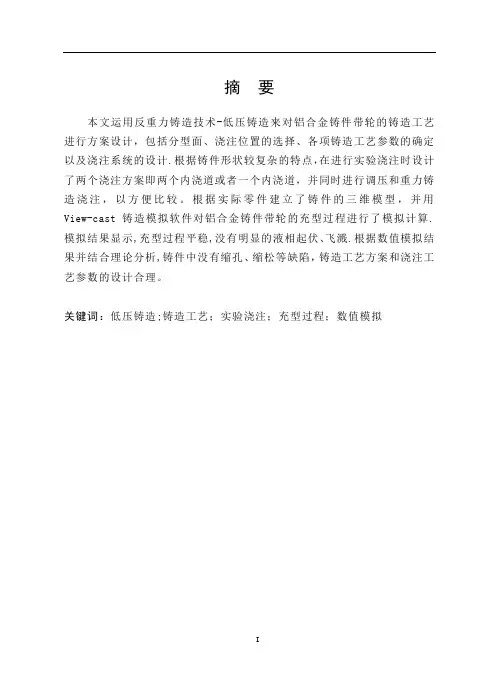
摘要本文运用反重力铸造技术-低压铸造来对铝合金铸件带轮的铸造工艺进行方案设计,包括分型面、浇注位置的选择、各项铸造工艺参数的确定以及浇注系统的设计.根据铸件形状较复杂的特点,在进行实验浇注时设计了两个浇注方案即两个内浇道或者一个内浇道,并同时进行调压和重力铸造浇注,以方便比较。
根据实际零件建立了铸件的三维模型,并用View-cast铸造模拟软件对铝合金铸件带轮的充型过程进行了模拟计算.模拟结果显示,充型过程平稳,没有明显的液相起伏、飞溅.根据数值模拟结果并结合理论分析,铸件中没有缩孔、缩松等缺陷,铸造工艺方案和浇注工艺参数的设计合理。
关键词:低压铸造;铸造工艺;实验浇注;充型过程;数值模拟AbstractIn this paper,anti—gravity casting technology,low pressure casting technology was used to complete the design of the casting of an aluminum alloy casting wheel,which include choice of Sub-surface and casting position,determining all of the parameters of the casting process,and the design of the casting system。
For the complex shape of the casting,when conducting experiments was designed to use two runners and one ingate for casting in one time, and at the same time,surge and gravity casting was used to make it easier to compare. For sand shell moulding, the mode of same time freezing was generally used. Build the Three-dimensional model of the casting, then simulate and calculate the filling process of casting。
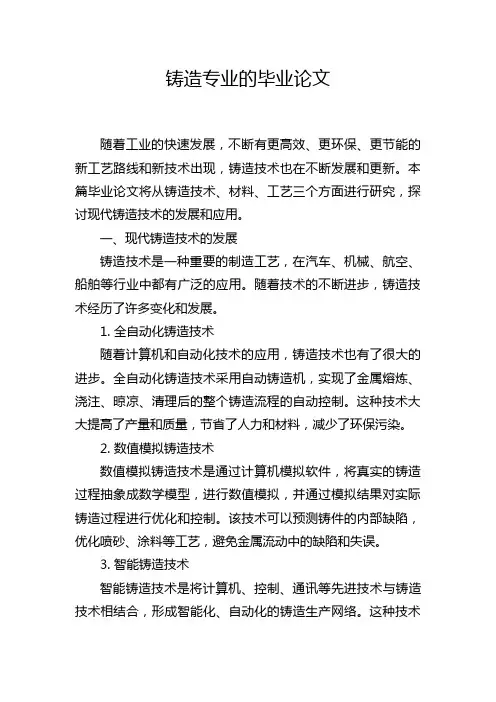
铸造专业的毕业论文随着工业的快速发展,不断有更高效、更环保、更节能的新工艺路线和新技术出现,铸造技术也在不断发展和更新。
本篇毕业论文将从铸造技术、材料、工艺三个方面进行研究,探讨现代铸造技术的发展和应用。
一、现代铸造技术的发展铸造技术是一种重要的制造工艺,在汽车、机械、航空、船舶等行业中都有广泛的应用。
随着技术的不断进步,铸造技术经历了许多变化和发展。
1. 全自动化铸造技术随着计算机和自动化技术的应用,铸造技术也有了很大的进步。
全自动化铸造技术采用自动铸造机,实现了金属熔炼、浇注、晾凉、清理后的整个铸造流程的自动控制。
这种技术大大提高了产量和质量,节省了人力和材料,减少了环保污染。
2. 数值模拟铸造技术数值模拟铸造技术是通过计算机模拟软件,将真实的铸造过程抽象成数学模型,进行数值模拟,并通过模拟结果对实际铸造过程进行优化和控制。
该技术可以预测铸件的内部缺陷,优化喷砂、涂料等工艺,避免金属流动中的缺陷和失误。
3. 智能铸造技术智能铸造技术是将计算机、控制、通讯等先进技术与铸造技术相结合,形成智能化、自动化的铸造生产网络。
这种技术不仅能监控铸造过程中的数据,还可以根据数据预测问题的解决方案并进行控制,大大提高了产品的质量和稳定性。
二、现代铸造材料的应用1. 高强度铸造合金高强度铸造合金是现代铸造材料的一种,其具有高强度、高韧性、高温稳定性等特性。
这种材料在国防、航空、航天等领域得到广泛应用。
2. 稀土元素稀土元素是一类具有重要物理、化学和生物学性质的元素,具有遮蔽轻有害辐射、提高合金耐热性能、增强弹性等优异特性,因此,稀土元素在铸造中应用广泛。
3. 新型材料随着材料科学的发展,新型材料的不断涌现和应用,使得铸造技术也更加精密和全面。
例如,金属陶瓷材料、碳纤维等,这些材料在汽车、飞行器、高速列车等轻质化方面具有广泛的应用前景,为铸造技术带来了新的发展机遇。
三、现代铸造工艺的探索1. 小型化和精密化随着科学技术的不断发展,小型化和精密化成为了现代工业发展的趋势和方向。
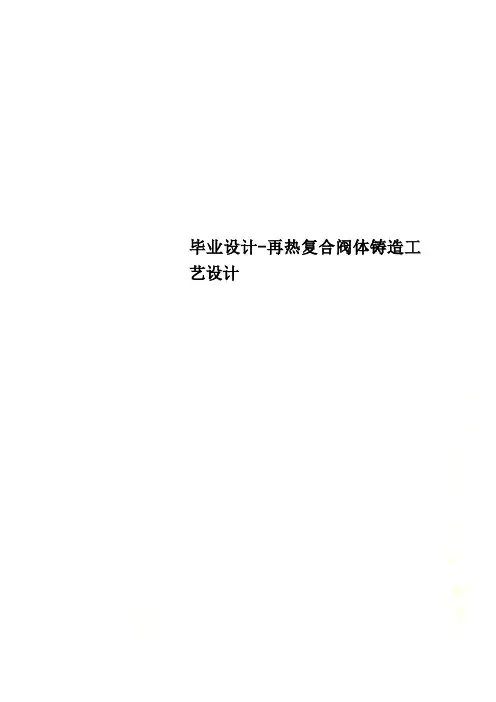
毕业设计-再热复合阀体铸造工艺设计再热复合阀体铸造工艺设计专业:材料成型及控制工程班级:2007级1班姓名:单景威目录摘要 (3)引言 (7)1内汽缸参数与主要技术要求 (9)1.1设计参数: (9)1.2主要技术要求: (10)2 铸造工艺设计方案 (11)2.1 零件结构的铸造工艺性分析: (11)2.1.1铸造工艺对零件结构的要求: (11)2.1.2为简化铸造工艺改进零件结构方法: (12)2.2 砂型铸造方法的分类与选择 (12)2.3 铸造工艺方案的确定 (13)2.3.1浇注位置的确定 (13)2.3.2分型面的确定 (15)2.4 砂芯设计 (17)2.4.1砂芯的固定和定位 (19)2.4.2芯头的设计 (19)2.4.3砂芯的排气 (20)2.5 冒口和冷铁设计 (21)2.5.1概述 (21)2.5.2铸钢件冒口设计 (22)2.5.3冷铁的设计: (26)2.6 浇注系统的设计 (29)2.6.1浇注系统的作用 (30)2.6.2对浇注系统的基本要求 (31)2.6.4浇注系统类型及特点 (34)3.铸造工艺设备设计 (35)3.1模样 (35)3.2砂箱 (35)3.2.1砂箱的选择和设计 (35)3.2.2砂箱尺寸 (35)3.2.3砂箱设计 (36)3.3定位方式 (36)4.铸钢件缺陷的分析与防止 (36)5.铸件铸造过程的温度模拟比较 (38)结论 (40)致谢 (42)参考文献 (43)随着科学技术的发展,要求金属铸件具有高的机械性能和尺寸精度,满足某些性能,如耐高温、耐磨等,同时要求铸件产量大,成本低。
一个铸件必须经过许多工序才能完成,从各种原材料准备开始,直到造型、制芯、合箱、浇注、落砂及清理为止,整个工艺过程都实行科学的操作,才能有效的控制铸件的形成,达到优质高产的效果。
铸件在生产之前,首先应编制出控制该铸件生产工艺过程的技术文件,称为铸造工艺设计。
铸造工艺设计是生产的指导性文件,因此,铸造工艺设计的好坏,对铸件的质量、生产率及成本起着很大的作用。
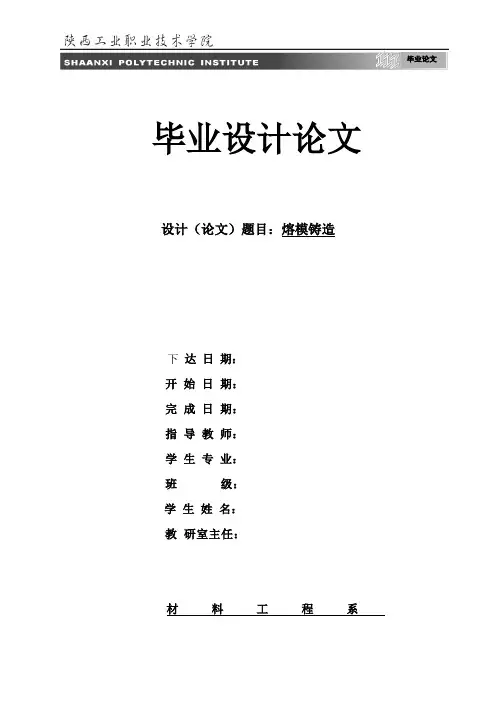
毕业论文毕业设计论文设计(论文)题目:熔模铸造下达日期:开始日期:完成日期:指导教师:学生专业:班级:学生姓名:教研室主任:材料工程系陕西工业职业技术学院毕业设计(论文)任务书一、设计(论文)内容及要求:(一)设计(论文)内容1. 撰写熔模技术发展现状的研究文章;2. 编制铸件(附零件图)铸造工艺规程,绘制铸造工艺图,填写铸造工艺过程卡片;3. 绘制铸件图和总装图;4. 设计熔模压型模具,绘制模具零件图;5. 撰写设计说明书(论文)。
(二)要求1.通过理论学习,熟悉熔模工艺过程,结合生产实际完成本次设计任务;2. 工程图用AutoCAD软件绘制并打印;3. 说明书(论文)按照学院统一格式,使用word文档并打印。
4. 提交资料包括:(1)毕业设计任务书;(2)熔模铸造技术发展现状的研究文章;(3)“四图一卡”,即绘制铸造工艺图;铸件图;零件图;铸型装配图;铸造工艺卡;(4)设计说明书(论文);所有提交的资料包括打印文件和电子文件。
二、技术指标:1.生产类型:大批大量生产2.生产及质量要求:满足产品图纸的各项技术要求;工艺出品率较高,废品率5%以下;生产效率高;对工人技术水平要求较低,操作简便。
3.生产工艺要求:熔模铸造;所用熔模模具自行设计;4.技术水平要求:尽量采用先进技术,创新项目应符合国家环保及安全生产要求。
陕西工业职业技术学院毕业设计(论文)任务书进程计划表摘要本设计是通过熔模铸造的方法来铸造管接头,先分析铸件,进行工艺设计,确定了主要参数,进行压型设计,绘制出铸件工艺图,进行熔模制造-型壳制造-脱蜡焙烧-熔炼浇注-后处理分析,结合具体零件,通过具体分析,最后有针对性的制定出材料为锡青铜的管接头熔模铸造工艺方案。
根据现实生产的应用,表明:熔模铸造适用于实际生产中管接头的铸造。
关键词:熔模铸造,锡青铜,工艺流程ABSTRACTThis design is through investment casting methods to cast pipe joints, first analysis of castings, for process design, to determine the main parameters for pressure-type design, the casting process to map out plans to carry out melt-mold making - Shell Manufacturing - Dewaxing roasting - Melting Pouring - post-processing analysis of specific parts, through a specific analysis, and finally to develop targeted materials bronze fittings of Investment Casting Process.Applications based on the realities of production, indicating that: the application of investment casting in the actual production of the control valve body casting.Key word:Melt mold casting, gun metal, technical process目录毕业设计任务书中文摘要英文摘要一、概述 (1)1、定义 (1)2、熔模铸造的特点 (1)3、发展历史 (2)4、应用范围 (2)二、熔模工艺设计 (4)1、零件图 (4)2、铸件结构工艺性分析 (4)3、确定工艺方案和工艺参数 (5)4、浇注系统 (7)5、绘制铸造工艺图 (10)三、压型设计 (11)1、装配图 (11)2、压型分类 (11)3、分型面选择 (12)4、型体设计 (13)5、压型排气 (16)6、压型冷却 (17)7、压型工作图设计 (17)8、注蜡孔的设计 (19)四、熔模的制造 (20)1、熔模 (20)2、模料的选取和配制 (20)3、制熔模 (21)4、制模组 (23)五、型壳的制造 (26)1、型壳服役性能的要求 (26)2、制造型壳的耐火材料及黏结剂 (26)3、制造型壳用涂料及配制 (27)4、制壳工艺 (31)六、脱蜡与焙烧 (34)1、脱蜡 (34)2、焙烧 (35)七、熔炼与浇注 (36)1、材料的选择 (36)2、选择炉型 (37)3、熔炼准备 (38)4、配料 (40)5、熔炼工艺 (42)八、铸件的后处理 (44)1、型壳的清理 (44)2、切割浇冒口 (46)参考文献 (47)致谢 (48)一、概述1、定义熔模铸造又称“失蜡铸造”,通常是在可熔模样的表面涂上数层耐火材料,待其硬化干燥后,加热将其中模样熔去,而获得具有与模样形状相应空腔的型壳,再经过焙烧,然后在型壳温度很高的情况下进行浇注,而获得铸件的一种方法,由于获得的铸件具有较高的尺寸精度和表面光洁度,故又称“熔模精密铸造”。
毕业论文毕业设计论文设计(论文)题目:熔模铸造下达日期:开始日期:完成日期:指导教师:学生专业:班级:学生姓名:教研室主任:材料工程系陕西工业职业技术学院毕业设计(论文)任务书一、设计(论文)内容及要求:(一)设计(论文)内容1. 撰写熔模技术发展现状的研究文章;2. 编制铸件(附零件图)铸造工艺规程,绘制铸造工艺图,填写铸造工艺过程卡片;3. 绘制铸件图和总装图;4. 设计熔模压型模具,绘制模具零件图;5. 撰写设计说明书(论文)。
(二)要求1.通过理论学习,熟悉熔模工艺过程,结合生产实际完成本次设计任务;2. 工程图用AutoCAD软件绘制并打印;3. 说明书(论文)按照学院统一格式,使用word文档并打印。
4. 提交资料包括:(1)毕业设计任务书;(2)熔模铸造技术发展现状的研究文章;(3)“四图一卡”,即绘制铸造工艺图;铸件图;零件图;铸型装配图;铸造工艺卡;(4)设计说明书(论文);所有提交的资料包括打印文件和电子文件。
二、技术指标:1.生产类型:大批大量生产2.生产及质量要求:满足产品图纸的各项技术要求;工艺出品率较高,废品率5%以下;生产效率高;对工人技术水平要求较低,操作简便。
3.生产工艺要求:熔模铸造;所用熔模模具自行设计;4.技术水平要求:尽量采用先进技术,创新项目应符合国家环保及安全生产要求。
陕西工业职业技术学院毕业设计(论文)任务书进程计划表摘要本设计是通过熔模铸造的方法来铸造管接头,先分析铸件,进行工艺设计,确定了主要参数,进行压型设计,绘制出铸件工艺图,进行熔模制造-型壳制造-脱蜡焙烧-熔炼浇注-后处理分析,结合具体零件,通过具体分析,最后有针对性的制定出材料为锡青铜的管接头熔模铸造工艺方案。
根据现实生产的应用,表明:熔模铸造适用于实际生产中管接头的铸造。
关键词:熔模铸造,锡青铜,工艺流程ABSTRACTThis design is through investment casting methods to cast pipe joints, first analysis of castings, for process design, to determine the main parameters for pressure-type design, the casting process to map out plans to carry out melt-mold making - Shell Manufacturing - Dewaxing roasting - Melting Pouring - post-processing analysis of specific parts, through a specific analysis, and finally to develop targeted materials bronze fittings of Investment Casting Process.Applications based on the realities of production, indicating that: the application of investment casting in the actual production of the control valve body casting.Key word:Melt mold casting, gun metal, technical process目录毕业设计任务书中文摘要英文摘要一、概述 (1)1、定义 (1)2、熔模铸造的特点 (1)3、发展历史 (2)4、应用范围 (2)二、熔模工艺设计 (4)1、零件图 (4)2、铸件结构工艺性分析 (4)3、确定工艺方案和工艺参数 (5)4、浇注系统 (7)5、绘制铸造工艺图 (10)三、压型设计 (11)1、装配图 (11)2、压型分类 (11)3、分型面选择 (12)4、型体设计 (13)5、压型排气 (16)6、压型冷却 (17)7、压型工作图设计 (17)8、注蜡孔的设计 (19)四、熔模的制造 (20)1、熔模 (20)2、模料的选取和配制 (20)3、制熔模 (21)4、制模组 (23)五、型壳的制造 (26)1、型壳服役性能的要求 (26)2、制造型壳的耐火材料及黏结剂 (26)3、制造型壳用涂料及配制 (27)4、制壳工艺 (31)六、脱蜡与焙烧 (34)1、脱蜡 (34)2、焙烧 (35)七、熔炼与浇注 (36)1、材料的选择 (36)2、选择炉型 (37)3、熔炼准备 (38)4、配料 (40)5、熔炼工艺 (42)八、铸件的后处理 (44)1、型壳的清理 (44)2、切割浇冒口 (46)参考文献 (47)致谢 (48)一、概述1、定义熔模铸造又称“失蜡铸造”,通常是在可熔模样的表面涂上数层耐火材料,待其硬化干燥后,加热将其中模样熔去,而获得具有与模样形状相应空腔的型壳,再经过焙烧,然后在型壳温度很高的情况下进行浇注,而获得铸件的一种方法,由于获得的铸件具有较高的尺寸精度和表面光洁度,故又称“熔模精密铸造”。
---文档均为word文档,下载后可直接编辑使用亦可打印--- 摘要本文通过对灰铸铁阀体的铸造工艺方案的设计,包括浇注位置、分型面的选择,砂芯和各项铸造工艺参数的确定以及浇注系统、砂箱、芯盒、模板的设计。
根据铸件小的特点,分为一箱四件,并采用封闭式的浇注系统的方法。
通过对凝固过程的温度场和铸造缺陷的分析,对工艺进行改进,然后绘制屏分析铸造工艺图与合箱图,将数据具体化,有效地调整工艺参数,减少可能出现的铸造缺降,保证工艺的可靠性。
最后设汁出合理的铸造工艺方案。
关键词:阀体;铸造工艺设计;浇注系统;铸造工艺图.AbstractIn this paper, the casting process design of gray iron valve cover, including casting location, parting surface selection, sand core and casting process parameters determination and casting system, sand box, core box, template design. According to the characteristics of small castings, it is divided into four parts in one box, and the method of closed casting system is adopted. By analyzing the temperature field of solidification process and casting defects, the process was improved, and then the screen was drawn to analyze the casting process diagram and box diagram, and the data was materialized to effectively adjust the process parameters, reduce the possible casting loss and ensure the reliability of the process. Finally, a reasonable casting process plan was established.Key words: valve cover; Casting process design; Casting system; Casting process drawing.目录一绪论 (6)1.1概述 (7)1.2铸造行业的历史 (8)1.3国内铸造行业的现状 (8)1.4铸造工艺(技术)发展展望 (9)1.5本课题的研究内容 (10)二铸件结构的工艺性 (10)2.1零件的设计 (10)2.2铸造工艺对铸件结构的要求 (12)三铸造工艺方案的设计 (13)3.1造型和造芯方法的选择 (13)3.2浇注位置的确定 (14)3.3分型面的选择 (15)3.4砂箱中铸件的数量及排列方式 (16)四铸造工艺参数及砂芯的设计 (16)4.1铸造工艺参数的确定 (16)4.2砂芯的设计 (21)五浇注系统的设计 (22)5.1浇注系统类型的选择 (22)5.2浇注系统尺寸的确定 (22)5.3直浇道的设计 (25)5.4横浇道的设计 (25)5.5内浇道的设计 (26)5.6浇口杯的设计 (27)5.7冒口的设计 (27)5.8冷铁的设计 (27)六铸造工艺装备设计 (27)6.1模样的设计 (27)6.2模板的设计 (28)6.3芯盒的设计 (31)6.4砂箱的设计 (32)七铸件的落砂、清理及后处理 (35)7.1铸件的冷却 (35)7.2落砂 (35)7.3表面清理 (35)7.4铸件的矫形 (35)7.5铸件的缺陷修补 (36)7.6铸件的内应力消除 (36)结论与展望 (36)参考文献 (38)小结引言重力铸造是指金属液在地球重力作用下注入铸型的工艺,也称浇铸。
挂舵臂铸造成形过程的计算机模拟摘要介绍了铸造过程数值模拟技术的一些基本的原理和应用。
采用华铸CAE软件对大型铸钢件挂舵臂的铸造成形过程温度场进行模拟。
选用了Solidworks三维造型软件生成铸件以及冒口、浇注系统、冒口套、冷铁等工艺参数的三维实体模型,并导出STL格式文件作为接口文件,然后用华铸软件进行模拟计算处理。
模拟结果作为改良挂舵臂铸造工艺的依据,在挂舵臂肋板热节处设置冷铁来提高凝固速度,在冒口上加设保温冒口套来提高冒口的金属液补缩能力。
通过对凝固过程温度场的模拟分析,优化了原始工艺。
利用计算机模拟技术,判断铸造工艺的合理性,辅助完成工艺优化的方法,能够彻底克服传统工艺设计方法的缺点,提高设计质量,缩短试制周期,降低生产成本。
将模拟优化后的工艺用于中信重机公司铸锻厂的实际生产中,结果表明:通过合理设置冒口、冷铁的位置和大小,合理选择浇注系统及分型面,可以控制冶炼和热处理工艺,保证铸件符合顺序凝固的原则,生产出组织致密、性能优良、各项指标达到用户要求的优质挂舵臂铸件。
关键字:挂舵臂,华铸CAE,缩孔,工艺优化Computer Simulation for Casting Process of Rudder ArmABSTRACTThis article has introduced the principles and applications of numerical simulation of casting process. HUA ZHU CAE been used to imitate the temperature field in the casting process of the large rudder arm.. In this experiment, Solidworks, a three-dimensional modeling software, has been used to create the three-dimensional entity model of casting and riser, pour system, riser set, cold iron, etc and lead out files whose forms are STL as the interface files. And then Intecast has been used to imitate the computing. The simulation result is used as the basic of improving the casting technology of the rudder horn. In order to enhance the speed of solidification, cold irons are set up in the rib hot spot of rudder arm. And to improve the contraction compensation capacity of molten metal of the riser head, the insulating riser sleeve has been set up. Through the simulation analysis the original technology has been optimized. Utilizing the computer modeling technique to judge the rationality of casting technology and to assist the optimization of casting technology can overcome the shortcoming of the traditional method on craft design completely. That can improve design quality and shorten production cycle as well as reduce the production cost.CITIC heavy machinery CO.adopted the optimized technology in the actual production. The results shows that cast of rudder arm with compact texture, high quality and satisfying parameters can be produced by properly setting the position and size of riser and cold iron, properly choosing perfusion system and parting plane,controling smelting and heat treatment process and ensuring that the cast accord to the principle of sequential solidification.KEY WORDS:rudder arm, HUA ZHU CAE, shrinkage, process optimization目录第一章绪论 (1)§1.1造船业的发展与挂舵臂铸件的介绍 (1)§1.2挂舵臂的传统铸造工艺 (3)§1.2.1 挂舵臂成型特点 (4)§1.2.2 传统铸造工艺 (4)第二章挂舵臂缩孔、缩松等缺陷的研究 (7)§2.1缩孔、缩松产生的原因和过程 (7)§2.2挂舵臂生产中缩孔、缩松等缺陷的产生 (8)§2.3挂舵臂生产中缩孔、缩松缺陷的防止 (9)§2.3.1 挂舵臂铸件中缩孔位置的确定 (9)§2.3.2 挂舵臂铸件生产中缩孔的防止 (11)第三章挂舵臂成形过程温度场数值模拟及工艺优化 (13)§3.1计算机技术在铸造生产中的应用 (13)§3.2华铸CAE的概述 (14)§3.3华铸CAE对挂舵臂铸造过程温度场的模拟 (16)§3.3.1 STL文件的前置处理 (16)§3.3.2 温度场的计算分析 (17)§3.3.3 模拟结果显示与分析 (19)§3.4挂舵臂铸造工艺优化 (20)第四章挂舵臂铸钢件的实际生产 (23)结论.. (27)参考文献 (28)致谢... .................................... 错误!未定义书签。
学号课程设计(论文)口盖压力铸造工艺设计及模具设计毕业设计教学系:指导教师:专业班级:学生姓名:课程设计任务书学生姓名: 专业班级:指导教师: 工作单位题目: 口盖压力铸造工艺设计及模具设计毕业设计初始条件:材料为08F-Ⅱ-S,料厚为2mm,大批量生产,尺寸如下图所示:要全套图纸的按住Ctrl点击这里:要学CAD该图纸的住Ctrl这里主要任务:1、查阅资料,分析零件的成形工艺,制定成形工艺方案,并进行设计计算;2、完成零件成形工艺中主要工序模具的详细设计计算;3、完成模具装配图、主要零件图的设计及绘制,绘图工作量不少于1张0号图纸;4、编写设计说明书(不少于3000字)。
时间安排:2015年10月26日设计动员、下达设计任务书2015年11月27日-11月29日制定设计方案,并进行工艺分析和计算2015年11月30日-2015年12月2日模具结构设计及模具装图绘制2015年12月3日-12月4日模具零件图绘制2015年12月5日整理、撰写设计说明书2015年12月6日设计考核指导教师(签名): 20115年 12 月 23 日负责人(签名):年月目录摘要……………………………………………………………………………………绪论…………………………………………………………………………………第一章零件图及工艺方案的拟订1.1 零件图及冲压件工艺分析 (9)1.2工艺方案的确定 (9)第二章工艺设计2.1计算毛坯尺寸 (10)2.2确定排样方案 (10)2.3计算各工序的压力 (11)2.4压力机的选取 (12)第三章模具类型及结构形式的选择3.1模具的典型结构 (13)3.2 定位装置 (13)3.3 卸料装置 (13)第四章模具零件的选用,设计及必要的计算4.1 模架的选择 (14)4.2 凸凹模固定板的选择 (14)4.3 磨柄的选择 (15)4.4 卸料装置 (15)4.5销、钉的选择 (16)第五章模具凸凹模的校核5.1凹模高度的校核 (16)5.1凸模的长度校核 (16)第六章总结及谢词 (17)【参考文献】 (19)摘要随着中国工业不断地发展,模具行业也显得越来越重要。
材料成型铸造专业毕业设计英文文献原文Casting and its processes1.1IntroductionManufacturing process can be classified into two general groups known as primary and secondary processes. The primary processes, namely, casting, forging, cold heading, cold extruding, brake forming, and so on, are those that convert raw material into shapes. These forming methods include both hot and cold working processes and, in general, will still require further finishing operations in order to obtain an end product.The secondary processes are those that bring the part to the dimensions and surface finish specified. One may also include in the secondary processes such operations as heat treating and surface treatments for corrosion resistance, hardness, and appearance. Secondary processes are planning , turning ,milling, drilling , boring , reaming , broaching , grinding , honing ,lapping , polishing , and special methods of metal removal such as electrochemical machining. Operations like screw cutting, tapping, thread milling, gear cutting, and so on ,are secondary processes that are merely adaptations of one of the aforementioned processes that are merely adaption of one of the aforementioned processes.A complete discussion of these procedures is beyond the scope of this text. Therefore, we will confine ourselves to succinct descriptions of the most prominent techniques.1.2 CastingsCastings are identified by the type of mold or the force required toy fill the mold. Molds are either permanent or expendable. The pattern of sand, shell, and plaster molds,however, can be used repeatedly for making new molds. As the metal cools, it takes the shape of the cavity. The basic casting methods are described below.Sand castings.1. The green sand process is one in which most, bonded sands packed around a wood or metal pattern. The pattern is then removed and molten metal is poured into the cavity .When the metal solidifies, the mold is broken and the casting is removed . Almost any metal can be used, with virtually no limit as to the size or shape of the part . The method permits casting complex components at a low tooling cost and is the most direct route from pattern to casting .Some machining is always necessary with the green sand process, and large castings have rough surface finish .Close tolerances are difficult to achieve, and long, thin projections should not be cast. It is possible , however , to design for bosses, undercuts and inserts .The minimum core hole diameter advisable are aluminum,3| 16—1|4 in. ;and the minimum section thicknesses advisable are aluminum ,3|16 in .;cooper , 3|32 in .; iron ,3|32 in .; magnesium,5|332 in ;and steel , 1|4—1|2 in .2. The dry sand process is similar to the green sand process except that core boxes are used inplace of patterns .This method is usually limited to smaller parts than method 1. The sand is bonded with a setting binder, and the core is then oven baked at 300—400 to remove the moisture.3.The carben dioxide sand process is one in which the sand molds are bonded whit sodium silicate solutions and set by forcing carbon dioxide gas through the sand .This type of mold is strong and permits the production of better dimensionallycontrolled castings than either method 1 or 2 .4 .The core—sand mold process is one where the molds are put together completely from oven baked cores set with organic binders such as oil or dextrines.Shell Mold Casting . This is a process where the molds are made by coating the sand with a thermosetting plastic .The mold is then supported on the outsaid by sand or shot, and molten metal is poured .When the metal has solidified , the mold is broken away from the finished casting. Shell molding produces casting with smooth surfaces, uniform grain structure ,high dimensional accuracy , rapid production rate and minimal amount of finishing operations . The minimum section thickniss castable is 1|16—1|4 in .but section differences where the maximum –minimum ratio is greater than 5 to 1 should be avoided. Bosses, undercuts and inserts are easily cast and the minimum cored hole diameter is 1|8—1|4 in .The method is relatively costly is limited to few metals.Full-Mold Casting .A process in which a green sand or cold-setting resin bonded is packed around a foamed plastic pattern (for example ,polystyrene ).The plastic pattern is vaporized with the pouring of the molten metal into the mold .An improved casting surface can be obtained by putting a refractory type of coating on the pattern surface before sand packing .The pattern can be one piece or several pieces , depending upon the complexity of the part to be cast .The plastic patterns are handled easily . They do not require any draft ,and produce no flash on the casting . For small quantity production this method can be expensive, depending upon the size and complexity of the casting .The minimum recommended section thickness is 0 .1 in .,and the maximum section thicknessis unlimited .Bosses, undercuts , and inserts present no problem in this type of casting . The minimum cored hole diameter is 1|4 in.Permanent Mold Castings .These are formed by a mold that can be used repeatedly . Some applications have reported as many as 25 000 castings being made from the same mold .Usually , the mold requires some redressing after about 3000 uses . The molds are machined of metal (for example ,gray iron ) for casting nonferrous metals and cast itons . Machined graphite molds are used to cast steel.This method produces castings that have a good surface finish as well as a good grain structure ,low porosity ,and high dimensional accuracy .The initial mold cost is relatively expensive, but castings weighing as little as several ounces to castings are limited to relativelysimple shapes and forms. The maximum recommended section thickness is about 2.0 in .The minimum thickness , however ,dependsuoon the material being cast as follows :3|16 in .for iton ,3|32—1|8 in .for aluminum, 5|32 in .for magnesium, and 3|32 –5|16 in .for copper .The minimum castable holes are 3|16—1|4 in .in diameter.Die Casting .A process used extensively in the quantity production of intricately shaped zinc, alumimum, lead and magnesium alloys .The method is limited in use with tin and copper alloys.Castings are formed by forcing molten metal under pressures of 1500-25 000 psi into an accurately machined steel die .The steel die ,which is water cooled ,is held together by a hydraulic press until the metal casting(s) solidifies., To ease the ejection of the cast parts, a lubricant is sprayed on the dieforming surface and the ejection pins. For small die cast components .,multiple cavity dies are used .The surface finish of the resulting castings is quite smooth and has excellent dimensional accuracy .Although the cost of production is relatively cheap ,the initial die cost is high .Diecasting is limited to nonferrous metals and by the size of the part that can be cast .The maximum wall section thickness is usually restricted to 3|16 in . but certainly to no greater than 0.50 in.Plaster Mold Casting .These are made by pouring a nonferrous alloy (for example , aluminum ,copper ,or zinc alloy ) into a plaster mold ,which is then broken to remove the solidified casting . The castings produced by this process are smooth, have high dimensional accuracy, low porosity, and can be made in many intricate shapes. The method, however, has disadvantages in that is limited to nonferrous metals, small castings and also requires a relatively long time to make the molds. The minimum wall section thickness is 0.040-0.060 in . for a cast area that is less than 2 sq .in . For larger cast areas ,the minimum wall thickness increased accordingly .The show process, developed within the last decade, is a cost promising method .It employs the use of plaster molds .This procedure produces castings with fine detail and excellent dimensional accuracy and surface finish.Ceramic Mold Casting . This process uses a mold made of a ceramic powder ,binder ,and gelling agent. The mold can also be made of a ceramic facing reinforced with a sand backing .The method is restricted to casting intricate parts requiring fine detail ,close tolerances ,and smooth finishes .The minimum wall thickness recommended is 0.025-0.050 in. There is, however, nolimit to the maximum wall thickness.Investment Casting. These are made when parts are desired that are intricate in shape ,have excellent surface finish , and require a high degree of dimensional accuracy .In addition ,this method of casting permits the use of a variety of metal alloys and does not have In addition ,this method of casting permits the use of a variety of metal alloys and does not have any metal flashing to be removed from the finishes casting.The technique of investment casting requires careful workmanship and expensive patterns and moths. The minimum castable wall thickness is about 0.025-0.050 in .and the maximum thickness should not exceed 3 in .Centrifugal Casting . This is a method of casting a shape by pouting the molten metal into a rotating fladk containing the mold .The molds are made of sand ,metal ,or graphite (depending on the metal cast ) and are rotated about their axial centers either in a horizontal or vertical position . Relatively large diameter and bulky components are made are pipe ,gun barrels, hollow shafts ,machinery drive rolls, long sleeves , tubing , and so on .Where the diameter to length ratio is rather large ,the rotational axis can be vertically mounted molds ,the method is called semmicentrifugal casting ,and it is used to make parts such as wheels, turbosupercharger diaphragms , disks ,flywheels ,and so on .Figure 1-5-2 shows a schematic section of a semicentrifugal casting of a cored flywheel .Generally, the method of centrifugal casting is expensive and is also limited in the shapes which can be cast .However ,the castings made by this mehod are very sound and have good dimensional accuracy .It should also be noted that this method is the only way to obtain a large cylindrical part.Continuous Casting.This is a method whereby a molten metal is continuously gravity fed from a ladle into an ingot mold of a desired shape which is open at both ends. As the metal ―falls‖through the mold , it takes its shape ,and is rapidly cooled by a water spray .It is then cut to specific lengths.The continuous casting process has the advantage of being low in cost and having a high rate of production .In addition, this method permits casting materials that cannot be extruded. However, continuous casting is restricted to shapes of uniform cross section (that is ,in the direction of casting),The minimum wall thickness depends on the shape being cast . The minimum size of casting is 1|2 in .and the maximum size is about 9 in .。
三明职业技术学院 毕业作业 毕业作业毕业作业 毕业作业
作业形式 作业形式作业形式 作业形式: :: :
毕业设计 毕业设计毕业设计 毕业设计
作业题目 作业题目作业题目 作业题目: :: :
机床 机床机床 机床JC23 JC23JC23 JC23- -- -63.4 63.463.4 63.4- -- -12 1212 12系列 系列系列 系列
滑块铸造工艺设计 滑块铸造工艺设计滑块铸造工艺设计 滑块铸造工艺设计
姓 姓姓 姓 名 名名 名: :: :
赖钟声 赖钟声赖钟声 赖钟声
学 学学 学
号 号号 号: :: :
080204158 080204158 080204158 080204158
所 所所 所
在 在在 在
系 系系 系: :: :
机械电子 机械电子机械电子 机械电子
专 专专 专
业 业业 业: :: :
机械制造与自动化 机械制造与自动化机械制造与自动化 机械制造与自动化
年 年年 年( (( (班 班班 班) )) )级 级级 级: :: :
0 00 08 88 8级 级级 级
学 学学 学
制 制制 制: :: :
三年制 三年制三年制 三年制
指导教师 指导教师指导教师 指导教师: :: :
陈龙波 陈龙波陈龙波 陈龙波
完成日期 完成日期完成日期 完成日期: :: :
2011 20112011 2011
年 年年 年 5 55 5
月 月月 月 15 1515 15 日 日日 日
1 摘 摘摘 摘
要 要要 要
机床JC23-63.4-12序列滑块是厦门锻压机床厂的生产的冲床上的关键部 件,材质为HT200,铸件重250Kg。铸件毛坯经抛丸清理和时效处理达到HB170~241 后,除了几处凸台、底面和两条导轨外,其余零件表面均不需要再加工。滑块底 面及导轨面不允许有砂眼、气孔、疏松等缺陷。根据以上要求及滑块的结构特点, 结合国内铸造技术的实际情况和我厂现有的设备,采用树脂砂作造型材料,木模 作为模样,再配合合理的分型面、铸造工艺参数、砂芯设计、浇注系统及冒口、 出气孔等设计,获得铸件表面质量、铸件几何尺寸精度方面比粘土烘模砂质量更 好的滑块铸件。 关键词 关键词关键词 关键词: :: :滑块;呋喃树脂砂;铸造工艺
2目 目目 目 录 录录 录 前言„„„„„„„„„„„„„„„„„„„„„„„„„„„„..„ 页 1 铸造工艺参数设计„„„„„„„„„„„„„„„„„„„„..„„ 页 1.1 滑块的生产条件、结构及技术要求„„„„„„„„„„„„ 页 1.2滑块铸造工艺性分析„„„„„„„„„„„„„„„„„„.. 页 1.3铸造工艺参数„„„„„„„„„„„„„„„„„„„„„.. 页 1.3.1 浇注位置的确定„„„„„„„„„„„„„„„„...„ 页 1.3.2分型面的确定„„„„„„„„„„„„„„„„„„„ 页
1.3.3铸件的起模斜度„„„„„„„„„„„„„„„„„„ 页 1.3.4 加工余量„„„„„„„„„„„„„„„„„„..„„ 页 1.3.5 收缩率„„„„„„„„„„„„„„„„„..„„„„ 页 1.3.6 铸件模样型芯头参数„„„„„„„„„„„„„„...„ 页 2 浇注系统的设计„„„„„„„„„„„„„„„„„„„„„„„ 页 2.1 工艺方案的确定„„„„„„„„„„„„„„„„„„„„ 页 2.1.1树脂砂发气量和发气速度„„„„„„„„„„„„„„ 页 2.1.2采用灰口铸铁浇注系统„„„„„„„„„„„„„„„ 页 2.1.3提高型芯的排气能力„„„„„„„„„„„„„„„„ 页 2.2 浇注系统的设计(应用大孔出流理论)„„„„„„„„„„„ 页 2.3 冒口的确定„„„„„„„„„„„„„„„„„„„„„„ 页 2.4 出气口的设计„„„„„„„„„„„„„„„„„„„„„ 页 3 铸造工艺装备设计„„„„„„„„„„„„„„„„„„...„„„ 页 3.1模样的设计„„„„„„„„„„„„„„„„„„.„„„„ 页 3.1.1模样材料的选用„„„„„„„„„„„„„„„„„„ 页 3.1.2金属模样尺寸的确定„„„„„„„„„„„„„„„„ 页 3.1.3壁厚与加强筋的设计„„„„„„„„„„„„„„„„ 页 3.1.4金属模样的技术要求„„„„„„„„„„„„„„„„ 页 3.1.5金属模样的生产方法„„„„„„„„„„„„„„„„ 页 3.2模板的设计„„„„„„„„„„„„„„„„„„„„„..„ 页
33.2.1模底板材料的选用 „„„„„„„„„„„„„„„„„ 页 3.2.2模底板尺寸确定„„„„„„„„„„„„„„„„„„ 页 3.2.3模底板与砂箱的定位„„„„„„„„„„„„„„„„ 页 3.3芯盒的设计„„„„„„„„„„„„„„„„„„„„„..„ 页 3.3.1芯盒的类型和材质„„„„„„„„„„„„„„„„„ 页 3.3.2芯盒的结构设计„„„„„„„„„„„„„„„„„„ 页 3.4砂箱的设计„„„„„„„„„„„„„„„„„„„„„ 页 3.4.1砂箱的材质及尺寸„„„„„„„„„„„„„„„„„ 页 3.4.2砂箱型壁尺寸及圆角尺寸„„„„„„„„„„„„„„ 页 3.4.3砂箱排气孔尺寸„„„„„„„„„„„„„„„„„„„„ 页 4 造型操作„„„„„„„„„„„„„„„„„„„„„„„„„„ 页 4.1 准备工作„„„„„„„„„„„„„„„„„„„„„.„„ 页 4.2 造型„„„„„„„„„„„„„„„„„„„„„„„.„„ 页 4.3 涂料„„„„„„„„„„„„„„„„„„„„„„„„„ 页 4.4下泥芯„„„„„„„„„„„„„„„„„„„„„„„..„ 页 5 滑块铸造生产质量检验„„„„„„„„„„„„„„„„„„„„ 页 5.1滑块铸件的技术要求„„„„„„„„„„„„„„„„„...„ 页 5.2滑块铸件质量的检验„„„„„„„„„„„„„„„„...„„ 页 6 铸件工艺出品率的校核„„„„„„„„„„„„„„„„.„„.„„ 页 7 零件图„„„„„„„„„„„„„„„„„„„„„„.„„„.„„ 页 8 总结„„„„„„„„„„„„„„„„„„„„„„„„„..„„„ 页 9 参考文献:„„„„„„„„„„„„„„„„„„„„„„..„„„ 页 10 致谢语:„„„„„„„„„„„„„„„„„„„„„„„„„„ 页
4前言 前言前言 前言
从八十年代初,尤其是1982年以后,随着改革开放政策的贯彻,我国与国 外合作生产的工厂增多,不少合作生产的外国厂家都对铸件生产提出来用自硬树 脂砂的要求,否则无法合作。对国内来说,以出口产品为主,对铸件质量的要求 也越来越高。于是在这种社会生产发展的新形势下,在国外树脂砂热的推动下, 迫使我国广大铸造工作者们认识到应用自硬树脂砂是造型工艺上的一场革命,是 提高铸件和机械产品质量的重要途径,是振兴铸造行业改变后面貌的必由之路, 是机械产品跃入国际市场的基本保证。因此八十年代我国铸造生产战线上形成了 “树脂砂热”。 由于自硬树脂砂最适合于多品种小批量的中大铸件生产,所以 机床行业、水泵行业、阀门行业和造船、石化等行业在树脂砂推广应用中走在最 前面。迄今为止,据不完全统计,我国已引进树脂砂处理生产线不下五十家,国 内有三大铸机厂(重庆、保定、漯河)已正式生产成套树脂砂设备。另外,生产 原辅助材料的厂家遍布各省,原辅助材料的质量进步很快,有些已接近或达到国 外同类产品的水平。事实表明用树脂砂工艺取代粘土烘模砂生产多种小批量中大 铸件是今后国内铸造业界的发展方向之一。 使用自硬呋喃树脂砂生产出来的具有以下特点:1、铸件表面光洁、棱角清 晰、尺寸精度高。2、造型效率高,提高了生产率和场地利用率,缩短了生产周 期。3、减轻劳动强度,大大改善了劳动条件和工作环境,尤其是减轻了噪音、 矽尘等,减少了环境污染。4、节约能源。这表现在取消了烘窑和水力清砂,提 高了铁水成品率,大大降低了压缩空气消耗,从而在节水、节电、节煤(焦)等